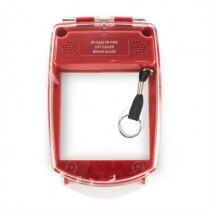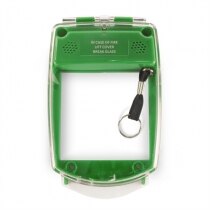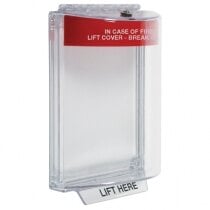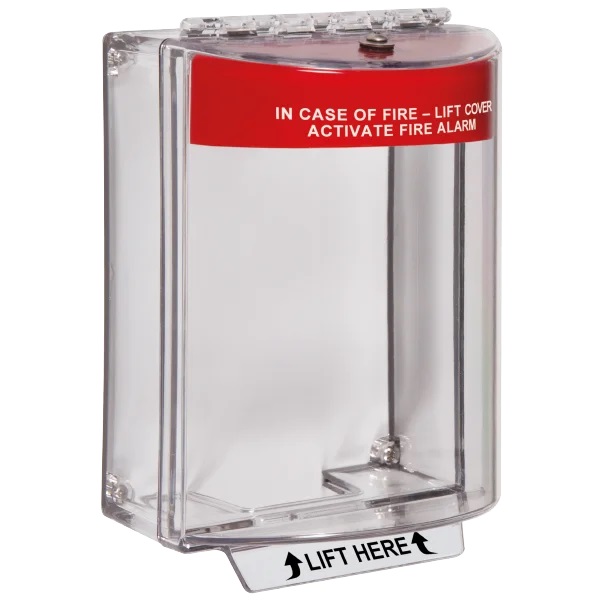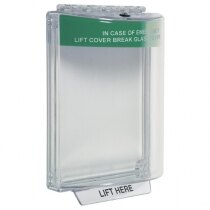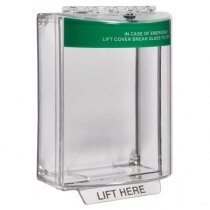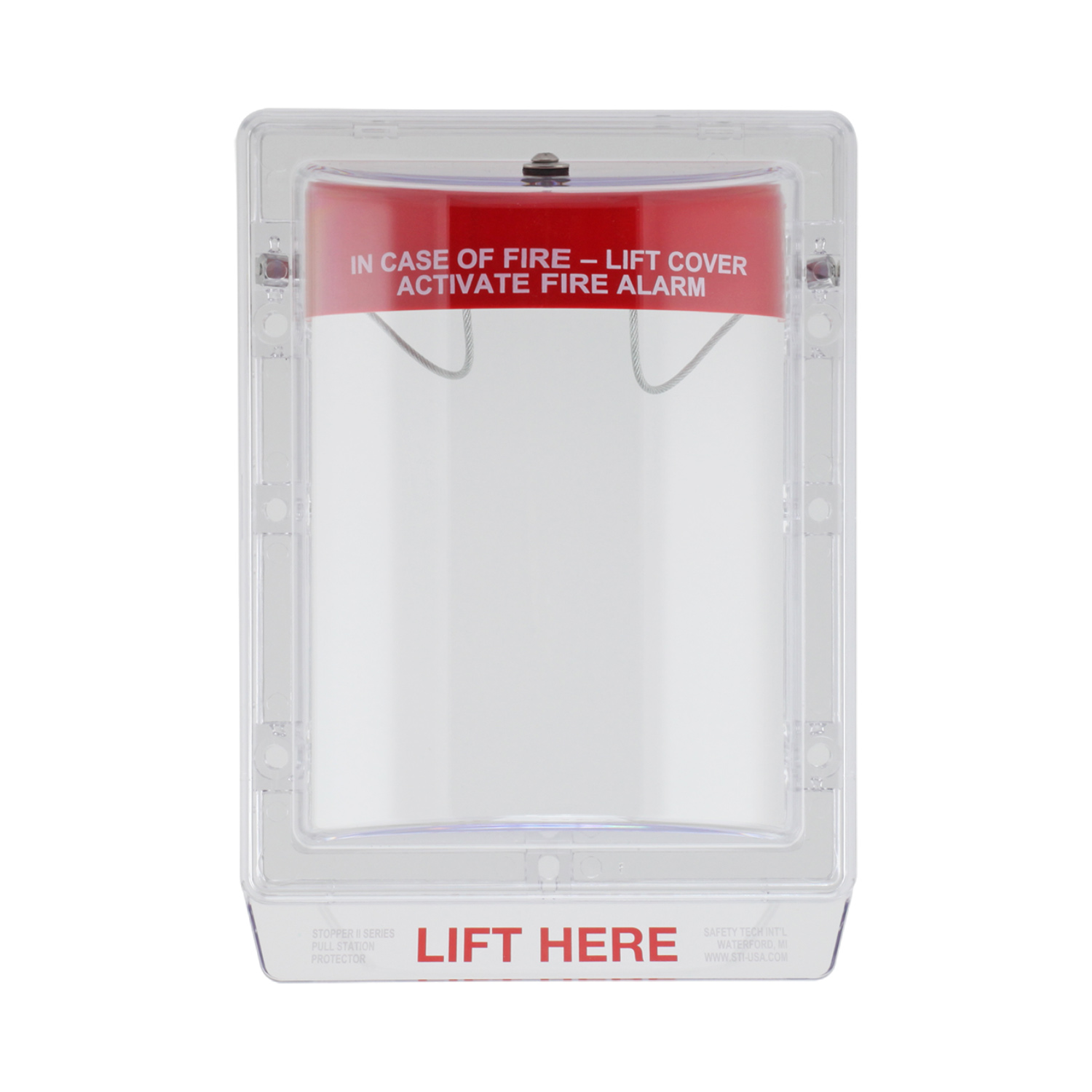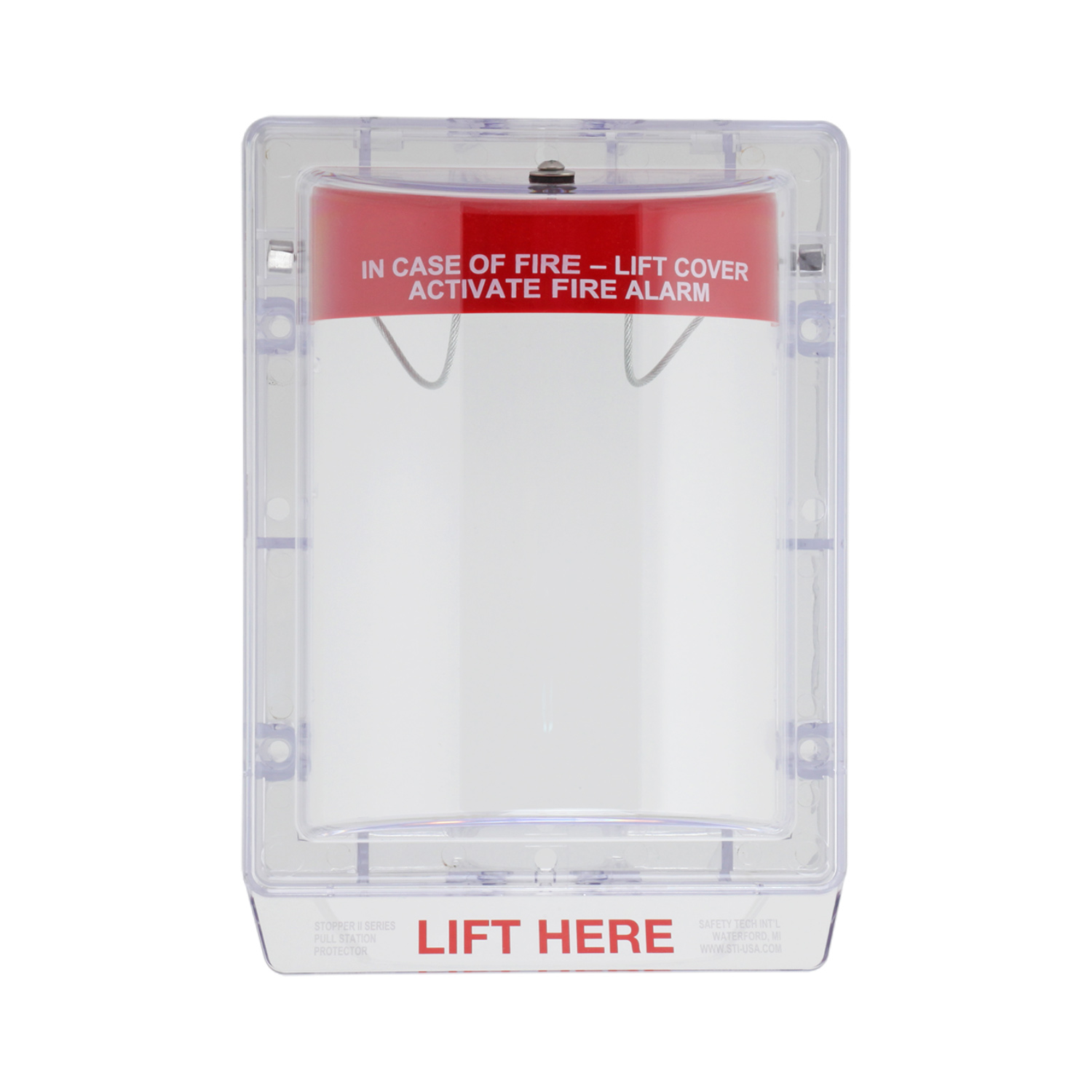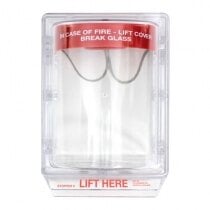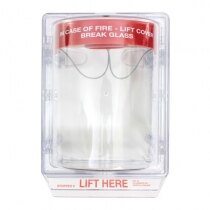-
Contact
Sales & Customer Service
0800 612 6537 support@safelincs.co.uk Live ChatDelivery Enquiries
0800 077 6149 - Resources
Fire & Safety Solutions
CALL OUR TEAM NOW 0800 612 6537
Also FREE from UK mobiles
Free Delivery
on 100s of Products
Live Chat - Online
Instant help & Advice
Trade Discounts
and exclusive pricing
0% Credit Available
Open an account now
5 Star Customer Feedback
Call Point Covers
Fire safety systems save lives, but they're only effective when they work correctly. That's where call point covers come in. These protective devices ensure your manual call points stay functional and visible, protecting them from accidental damage, tampering, and harsh environmental conditions that could compromise their operation when you need them most. What are call point covers, and why do you need them? Call point covers are protective shields designed to safeguard manual fire alarm call points from damage, interference, and environmental factors. They create a transparent barrier that keeps the call point visible and accessible during emergencies, but prevents accidental activation, deliberate tampering, or damage from everyday activities. These covers serve multiple purposes in your fire safety strategy. They protect against dust, moisture, and physical impacts that could prevent proper operation. They also deter vandalism and accidental triggers that create false alarms, saving you from unnecessary disruption and potential fines. How do call point covers protect your fire safety investment? Your call points represent a significant investment in building safety. Without proper protection, they're vulnerable to damage from cleaning activities, construction work, weather exposure, and general wear and tear. Call point covers extend the lifespan of your equipment by creating a protective barrier that prevents these common issues. The covers we stock are designed to be easily removable during genuine emergencies. Breaking the cover to access the call point creates a clear indication that the alarm has been activated, helping to identify the source of activation during evacuation procedures quickly. Are call point covers suitable for all environments? Modern call point covers are engineered to perform in various settings, from busy office buildings to industrial facilities and outdoor installations. They're manufactured from durable materials that resist UV degradation, temperature fluctuations, and chemical exposure. Indoor applications benefit from covers that protect against dust, cleaning chemicals, and accidental contact. Outdoor installations require covers that withstand weather conditions, temperature changes, and UV exposure without becoming brittle or discoloured. What types of call point covers are available? Call point covers are available in several configurations to accommodate various call point types and installation requirements. Universal covers fit most standard call point designs, providing versatile protection for mixed installations. Specific manufacturer covers ensure perfect compatibility with particular call point models. Some covers include additional features like anti-tamper mechanisms, weatherproof seals, or enhanced visibility elements. These specialist options provide extra protection in challenging environments or high-risk locations where tampering is a concern. How do you choose the right call point cover? Selecting the appropriate cover depends on your specific call point model, environmental conditions, and protection requirements. Start by identifying your call point manufacturer and model to ensure compatibility. Consider the installation location and any specific challenges, such as weather exposure, high-traffic areas, or potential tampering risks. We stock covers from leading manufacturers, ensuring quality and reliability. Our range includes options for different budgets and protection levels, from basic protective covers to advanced anti-tamper solutions with enhanced security features. Can call point covers affect emergency response times? Properly designed call point covers improve emergency response by ensuring call points remain functional and visible. They prevent false alarms that could delay genuine emergency responses, and their transparent design maintains the visual prominence of call points during emergencies. The covers are designed to break away cleanly when the call point is activated, creating minimal delay in alarm activation. This breakaway action also provides clear evidence of which call point was used, helping emergency responders quickly locate the source of the alarm. How do you maintain call point covers? Call point covers require minimal maintenance but benefit from regular inspection and cleaning. Check covers periodically for cracks, discolouration, or damage that could affect their protective function. Clean them with appropriate solutions to maintain transparency and visibility. Replace covers showing signs of damage, as compromised covers may not provide adequate protection. Keep spare covers available for quick replacement after genuine activations or accidental damage. Do call point covers comply with fire safety regulations? Quality call point covers are designed to meet relevant fire safety standards and regulations. They maintain the required visibility and accessibility of call points as demanded by building regulations. However, it's essential to verify that any covers you install comply with local fire safety requirements and building codes. We ensure that our call points meet the appropriate standards and provide the necessary documentation for compliance purposes. This gives you confidence that your fire safety system remains compliant and effective. Are call point covers cost-effective? Call point covers offer excellent value when considering the cost of replacing damaged call points or dealing with false alarms. The investment in covers typically pays for itself through reduced maintenance costs, fewer false alarms, and extended equipment life. The cost of a false alarm callout often exceeds the price of protective covers for multiple call points. By preventing accidental activations and protecting your equipment, covers deliver ongoing savings that justify their initial cost. Protect your fire safety investment with quality call point covers from Safelincs. Browse our comprehensive range to find the perfect solution for your installation, or contact our fire safety experts for personalised advice on protecting your call points effectively. Consider our full range of anti-vandal protection and fire alarm accessories to complete your protection strategy, and read our helpful guide about fire alarm testing requirements. Frequently Asked Questions (FAQs) Do all call points need protective covers? Not every call point requires a cover. The need depends on location, environment, and local safety regulations. Covers are typically recommended for high-traffic areas, outdoor installations, or places where accidental activation or vandalism is likely. What's the difference between red and green call point covers? Red covers are used for fire-related emergencies and fire alarm call points. Green covers typically protect emergency exit controls and door release access systems. The colour coding helps users quickly identify the function during emergencies. Can you fit covers to existing call points? Yes, call point covers can be retrofitted onto existing equipment. They're designed to work with both flush-mounted and surface-mounted devices, making them suitable for upgrading current installations without requiring the replacement of the call points themselves. Are call point covers available with built-in sounders? Some call point covers come with integrated sounders, whilst others are designed for silent operation. The choice depends on your specific requirements and whether additional audible alerts are needed at the call point location. Do the covers affect emergency access to call points? No, properly designed covers maintain full emergency access. They feature hinged lids that keep call points visible and accessible during genuine emergencies, while also protecting against accidental activation and environmental damage.
Read more about call point covers...
Waterproof Call Point Cover - Flush Mounted - Sigma Smart+Guard Enviro SG-F-W Range
- Protects call points against vandalism and misuse
- Waterproof - ideal for hostile environments
- Available with or without audible alarm
- Flush mounted design
- Can be retrofitted over an existing device
Call Point Cover - Flush Mounted - Sigma Smart+Guard SG-F Range
- Protects call points against vandalism and misuse
- Tough polycarbonate protective cover
- Available with or without audible alarm
- Flush mounted design
- Can be retrofitted over an existing device
Call Point Cover - Surface Mounted - Sigma Smart+Guard SG-S Range
- Protects call points against damage and misuse
- Durable polycarbonate protective cover
- Available with or without audible alarm
- Surface mounted design
- Can be retrofitted over existing equipment
Waterproof Call Point Cover - Surface Mounted - Sigma Smart+Guard Enviro SG-S-W Range
- Protects call points against damage and misuse
- Waterproof - ideal for hostile environments
- Available with or without an audible alarm
- Surface mounted design
- Can be retrofitted over an existing device
Green Call Point Cover - Flush Mounted - Sigma Smart+Guard SG-F Range
- Protects door release call points and switches
- Strong polycarbonate construction
- Available with or without audible alarm
- Flush mounted design
- Suitable to fit over existing equipment
Green Waterproof Call Point Cover - Flush Mounted - Sigma Smart+Guard Enviro SG-F-W Range
- Ideal for the protection of door release call points
- Waterproof - designed for hostile environments
- Available with or without sounder
- Flush mounted design
- Can be retrofitted over existing equipment
Green Call Point Cover - Surface Mounted - Sigma Smart+Guard SG-S Range
- Protects door release call points and switches
- Durable polycarbonate cover
- Available with or without 90dB sounder
- Surface mounted design
- Easy to install over existing equipment
Green Waterproof Call Point Cover - Surface Mounted - Sigma Smart+Guard Enviro SG-S-W Range
- Protects door release call points and switches
- Waterproof - designed for hostile environments
- Available with or without an audible alarm
- Surface mounted design
- Suitable to fit over existing equipment
Call Point Cover - Flush Mounted Universal Stopper STI 13010FR / STI 13020FR
- Flush mounted fire alarm call point cover
- Designed to protect call points from accidental activation, vandalism and the elements
- Easy to install and designed to add protection to existing call points
- Improved design replaces the STI Stopper and Stopper 2 product ranges
Call Point Cover - Surface Mounted Universal Stopper STI 13110FR / STI 13120FR
- Surface mounted fire alarm call point cover
- Designed to protect call points from accidental activation, vandalism and the elements
- Easily installed, with exceptional damage resistance to add protection to your call points
- Improved design replaces the STI Stopper and Stopper 2 product ranges
Access Control Cover - Flush Mounted Universal Stopper STI 13010EG / STI 13020EG
- Flush mounted green access control point cover
- Designed to protect access control points from accidental activation, vandalism and the elements
- Easy to install and designed to add protection to existing access control equipment
- Improved design replaces the STI Stopper and Stopper 2 product ranges
Access Control Cover - Surface Mounted Universal Stopper STI 13110EG / STI 13120EG
- Surface mounted green access control point cover
- Designed to protect access control points from accidental damage, activation and the elements
- Simple installation easily adds protection to existing access control equipment
- Improved design replaces the STI Stopper and Stopper 2 product ranges
Call Point Cover 'Stopper 2' STI 1200 (for flush mounted call points)
- Flush mounted call point cover
- Larger version of the STI 'Stopper' series call point cover
- Protects equipment from accidental operation, vandalism, product misuse, dust and weather
- Simple installation, can retrofit over existing call point
Call Point Cover 'Stopper 2' STI 1230 (for surface mounted call points)
- Surface mounted call point cover
- Larger version of 'Stopper' 6500 series call point cover
- Protects equipment from accidental operation, vandalism, product misuse, dust and weather
- Easy to install, can be retrofitted over existing call points
Call Point Cover 'Stopper 2' with Sounder STI 1100 (for flush mounted call points)
- Surface mounted call point cover with built-in sounder
- Larger version of 'Stopper' 6500 series call point cover
- Protects equipment from accidental operation, vandalism, product misuse, dust and weather
- Easy installation, can be retrofitted over existing call points
Call Point Cover 'Stopper 2' with Sounder STI 1130 (for surface mounted call points)
- Surface mounted call point cover with sounder
- Larger version of the 'Stopper' 6500 series call point cover
- Protects equipment from accidental operation, vandalism, product misuse, dust and weather
- Simple installation, can retrofit over existing call point
What is the difference between a red and green call point cover?
The difference between a red and green call point typically indicates their functions in emergency systems:
Red Call Point Cover- Emergency Use: These are mostly found on fire alarm call points. The action of lifting the red cover activates the fire alarm in the event of an emergency. Red is universally associated with fire safety; therefore, these call points are used to indicate immediate danger and emergency use.
- Emergency Exit: Green covers are often found on call points related to emergency exits or door release systems. Green is mainly associated with safety or escape. In most cases, they are used for non-fire-related emergencies, such as opening a locked door in an evacuation scenario.
Overall, red indicates fire-related emergencies, whilst green is typically used for emergency exits or access control systems.
Do all call points and access control buttons require a cover?
Not all call points and access control buttons require a cover. The requirement of a cover depends on many factors such as their location, application, environment and compliance with local building and safety regulations.
Call Points (e.g., Emergency Fire Alarm Call Points)
Covers for call points, particularly those used in fire alarm systems, are frequently recommended or required in certain situations:
- Prevention of Accidental Activation: Covers help in preventing accidental activations of alarms, particularly covers with flip-open designs. These are often required in high-traffic areas like schools, shopping centres, or industrial sites.
- Outdoor or Harsh Environments: In locations that are exposed to the elements (rain, dust, humidity, etc.), a weatherproof cover is often required to protect the call point from damage or malfunction.
- Tamper Resistance: In areas where tampering or vandalism may be a concern, covers (some with built-in alarms) are used to deter unauthorised or false activations.
Access Control Buttons (e.g., Exit Buttons)
For access control buttons (such as door release buttons):
- Outdoor or Harsh Environments: Similar to call points, access control buttons in outdoor settings or industrial environments may need covers for protection against the weather, dust, or other harsh conditions.
- Accidental Use Prevention: A cover might be used in some scenarios to prevent unintentional pressing of an access button, especially in high-traffic areas.
- Compliance with Regulations: Some security or fire safety regulations may require protective covers for certain types of access control buttons, particularly if they are part of an emergency escape.




















